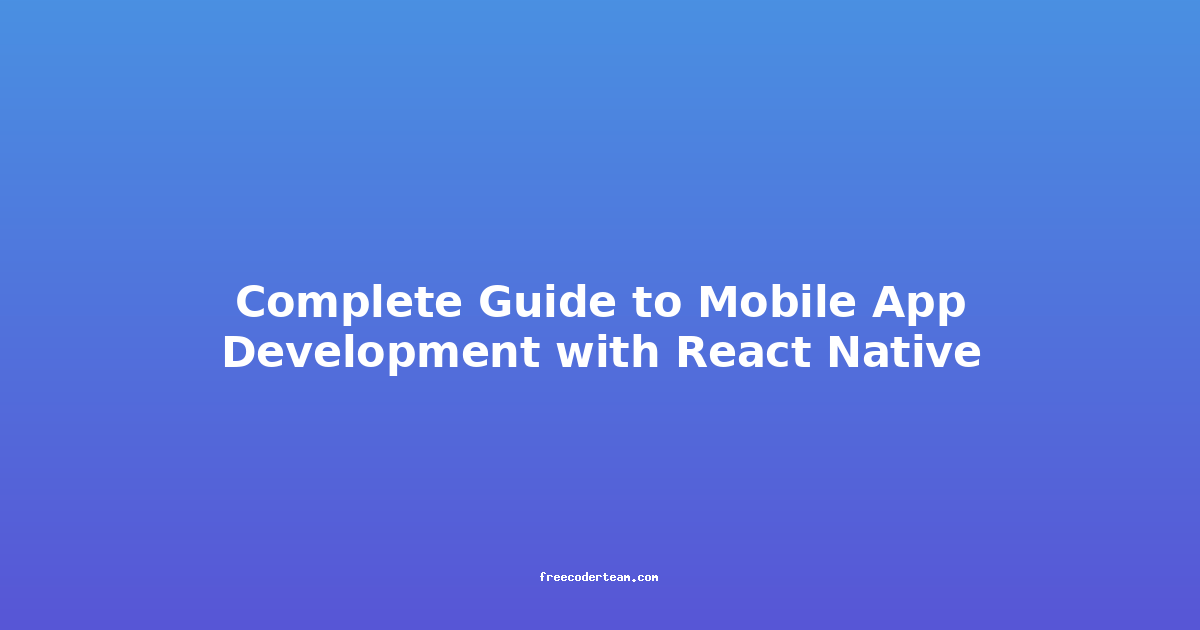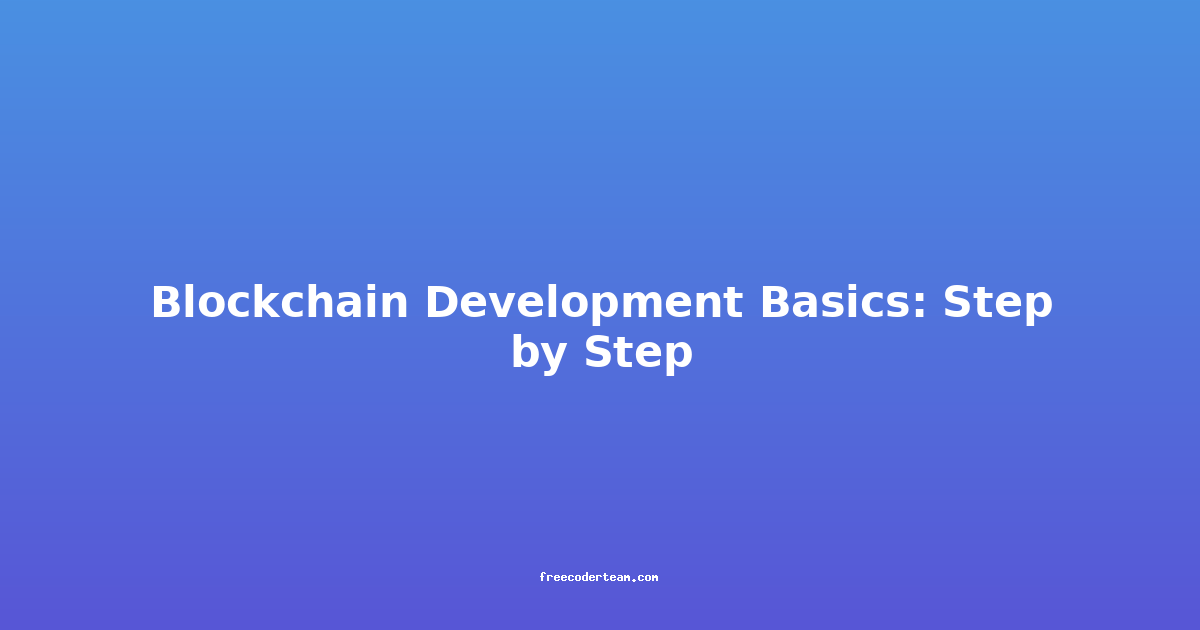Complete Guide to Mobile App Development with React Native
React Native is one of the most popular frameworks for building cross-platform mobile applications. It allows developers to write code once and deploy it on both iOS and Android platforms, making it an efficient and cost-effective choice for startups and enterprises alike. In this comprehensive guide, we'll explore the essentials of React Native, from setup to deployment, with practical examples, best practices, and actionable insights.
Table of Contents
- Introduction to React Native
- Setting Up Your Development Environment
- Building Your First React Native App
- Core Concepts and Best Practices
- Using Native Features
- Performance Optimization
- Deployment and Publishing
- Conclusion
Introduction to React Native
React Native is a JavaScript framework developed by Facebook that allows developers to build native mobile applications using React, a popular front-end library. Unlike web applications, React Native compiles your JavaScript code into native code, ensuring a smooth and performant user experience. Its main advantages include:
- Cross-Platform Development: Write code once and deploy on both iOS and Android.
- Large Ecosystem: Access to a vast number of libraries and tools.
- Hot Reloading: Instantly see changes in your app without restarting.
- Familiar Syntax: Leverages JavaScript and React, making it accessible to web developers.
Setting Up Your Development Environment
Before diving into app development, you need to set up your environment. Here's a step-by-step guide:
1. Install Node.js and npm
React Native requires Node.js and npm (Node Package Manager). Visit Node.js to download and install the latest version.
2. Install React Native CLI
The React Native CLI is the primary tool for creating and managing React Native projects. Install it globally using npm:
npm install -g react-native-cli
3. Install Expo (Optional)
Expo is a popular tool for React Native development that simplifies the setup process and offers cloud-based development features. You can install it using npm:
npm install -g expo-cli
4. Set Up Android and iOS Development Environments
- Android: Install the Android Studio IDE, which includes the Android SDK. Ensure you have at least API level 29 or higher.
- iOS: Install Xcode and ensure you have a Mac for iOS development.
5. Verify Installation
Run the following command to check if everything is set up correctly:
npx react-native --version
If you see the version number, you're ready to start building apps!
Building Your First React Native App
Let's create a simple "Hello, World!" app to get you started.
1. Create a New Project
Use the React Native CLI to create a new project:
npx react-native init MyFirstApp
This command creates a new directory MyFirstApp with the necessary files and dependencies.
2. Navigate to the Project Directory
cd MyFirstApp
3. Run the App
You can run your app on an emulator, simulator, or physical device.
For Android:
npx react-native run-android
For iOS:
npx react-native run-ios
4. Update the App
Open the App.js file in your project directory and replace the default code with the following:
import React from 'react';
import { View, Text, StyleSheet } from 'react-native';
const App = () => {
return (
<View style={styles.container}>
<Text style={styles.title}>Hello, World!</Text>
</View>
);
};
const styles = StyleSheet.create({
container: {
flex: 1,
justifyContent: 'center',
alignItems: 'center',
backgroundColor: '#2196F3',
},
title: {
fontSize: 24,
color: 'white',
},
});
export default App;
This code creates a simple view with a centered "Hello, World!" text.
5. Restart the App
Save the file and your changes will automatically reload in the app (thanks to Hot Reloading!).
Core Concepts and Best Practices
1. Components
React Native uses components to build reusable UI elements. Components can be stateless (functional components) or stateful (class components). Here's an example of a functional component:
import React from 'react';
import { Text, View } from 'react-native';
const Greeting = ({ name }) => {
return (
<View>
<Text>Hello, {name}!</Text>
</View>
);
};
export default Greeting;
2. State Management
Use useState for managing state in functional components:
import React, { useState } from 'react';
import { View, Text, Button } from 'react-native';
const Counter = () => {
const [count, setCount] = useState(0);
return (
<View>
<Text>Count: {count}</Text>
<Button title="Increment" onPress={() => setCount(count + 1)} />
</View>
);
};
export default Counter;
3. Styling
React Native uses StyleSheet for styling:
import React from 'react';
import { View, Text, StyleSheet } from 'react-native';
const StyledComponent = () => {
return (
<View style={styles.container}>
<Text style={styles.title}>Styled Text</Text>
</View>
);
};
const styles = StyleSheet.create({
container: {
flex: 1,
justifyContent: 'center',
alignItems: 'center',
backgroundColor: '#f5fcff',
},
title: {
fontSize: 24,
fontWeight: 'bold',
color: '#333',
},
});
export default StyledComponent;
4. Navigation
Use libraries like React Navigation to handle screen transitions:
npm install @react-navigation/native react-native-screens react-native-safe-area-context @react-navigation/stack
Then, set up navigation in your App.js:
import React from 'react';
import { NavigationContainer } from '@react-navigation/native';
import { createStackNavigator } from '@react-navigation/stack';
import HomeScreen from './screens/HomeScreen';
import DetailsScreen from './screens/DetailsScreen';
const Stack = createStackNavigator();
const App = () => {
return (
<NavigationContainer>
<Stack.Navigator>
<Stack.Screen name="Home" component={HomeScreen} />
<Stack.Screen name="Details" component={DetailsScreen} />
</Stack.Navigator>
</NavigationContainer>
);
};
export default App;
Using Native Features
React Native provides access to native APIs for features like GPS, camera, or notifications. You can use libraries like React Native Permissions or React Native Camera.
Example: Using Geolocation
Install the react-native-geolocation-service library:
npm install react-native-geolocation-service
Then, use it in your app:
import React, { useEffect, useState } from 'react';
import { Alert, Text, View } from 'react-native';
import Geolocation from 'react-native-geolocation-service';
const LocationComponent = () => {
const [location, setLocation] = useState(null);
useEffect(() => {
Geolocation.getCurrentPosition(
position => {
setLocation({
latitude: position.coords.latitude,
longitude: position.coords.longitude,
});
},
error => {
Alert.alert('Error', error.message);
},
{ enableHighAccuracy: true, timeout: 15000, maximumAge: 10000 }
);
}, []);
return (
<View>
{location ? (
<Text>
Latitude: {location.latitude}, Longitude: {location.longitude}
</Text>
) : (
<Text>Getting location...</Text>
)}
</View>
);
};
export default LocationComponent;
Performance Optimization
To ensure your app runs smoothly, consider the following:
-
Use FlatList for Large Data Sets: Instead of rendering large lists with
map, useFlatListfor better performance.import React from 'react'; import { FlatList, Text, View } from 'react-native'; const data = Array.from({ length: 1000 }, (_, i) => `Item ${i + 1}`); const ListComponent = () => { return ( <FlatList data={data} keyExtractor={(item) => item} renderItem={({ item }) => <Text>{item}</Text>} /> ); }; export default ListComponent; -
Avoid Over-Rendering: Use
useMemoanduseCallbackto memoize expensive computations and functions. -
Optimize Images: Use libraries like React Native Fast Image for better image loading performance.
Deployment and Publishing
To publish your app, you need to build it for the respective platform:
1. Build for Android
cd android
./gradlew assembleRelease
This generates an .apk file in the app/build/outputs/apk/release directory.
2. Build for iOS
Open your project in Xcode and archive it for release.
3. Publish to App Stores
- Google Play Store: Upload the
.apkfile to the Google Play Console. - App Store: Use App Store Connect to submit your iOS app.
Conclusion
React Native is a powerful tool for building cross-platform mobile applications. With its flexibility, large community, and robust ecosystem, it's an excellent choice for developers looking to create high-quality apps efficiently. By following best practices, leveraging native features, and optimizing performance, you can build apps that users love.
Whether you're a beginner or an experienced developer, React Native offers a smooth learning curve and a wealth of resources to help you succeed. Start building your first app today and join the growing community of React Native developers!
Feel free to explore the official React Native Documentation and React Native Community for more insights and examples. Happy coding! 🚀
Note: Always ensure you have the latest versions of dependencies and development tools to avoid compatibility issues.




